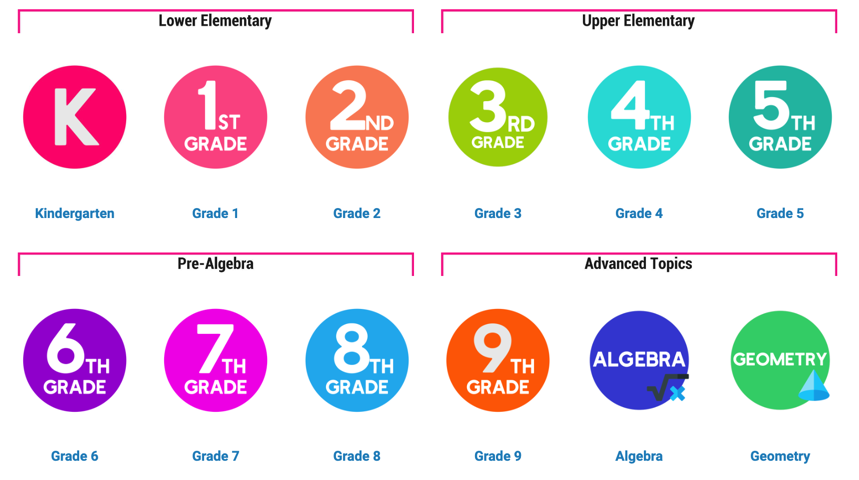Area and Perimeter Worksheets
Free Area and Perimeter Worksheets with Answer Keys
Are you searching for free Area and Perimeter Worksheets to share with your students at home or in your classroom?
Welcome to this free library of area and rerimeter worksheets (with full answer keys), which you can use to practice how to find the area and/or the perimeter of geometric shapes and figures. Below you will find a small library of free Area and Perimeter worksheets than can be download as PDF files that are super easy to print and share.
Understanding how to find area and perimeter of 2D shapes (and how to solve problems involving area and perimeter) is an important foundational math skill that every student must learn at some point. By learning some key definitions (namely that area represents the number of square units it would take to cover the surface inside of a closed figure, and that perimeter represents the total distance around the outer boundary of a closed figure) and simple math procedures, and with plenty of practice, you can learn how to find the area and perimeter of a figure.
Are you ready to start working on a few area and perimeter worksheets? If so, continue onto the next section of this page, where you will find several practice worksheets related to area and perimeter—including finding the area and perimeter of squares, rectangles, and triangles, finding the perimeter of irregular rectangular shapes, and solving area and perimeter work problems.
You can preview any worksheet by clicking on the corresponding blue text link, which will open the PDF preview page. From there you can easily download the PDF file to your computer or send it to your print (you have the option of printing each area and perimeter worksheet with or without the answer key).
All of the area and perimeter worksheets include an answer key on the second page so that you can check your work and assess your progress. Each worksheet is a sample from the Mashup Math Infinite Worksheet Library, where you can download hundreds of more topic-specific math worksheets for grades K-12.
Area and Perimeter Worksheets
Area and Perimeter Worksheets
(Simple 2D Figures)
Click Image to Preview
▶️ Find the perimeter of each figure (A)
▶️ Find the perimeter of each figure (B)
▶️ Find the perimeter of each figure (C)
▶️ Find the area of each rectangle (A)
▶️ Find the area of each rectangle (B)
▶️ Find the area of each rectangle (C)
▶️ Draw the figure given the area (grid) (A)
Area and Perimeter Worksheets
(Advanced)
Click Image to Preview
Area and Perimeter Worksheets
(Word Problems)
Click Image to Preview
🛑 WAIT UP! Would You Like More Topic-Specific Worksheets for Grades K-9+? 🙋♀️
Check out our Free Math Worksheets Library, where you will find hundreds of PDF math worksheets with complete answer keys for Grades K-12!
Area and Perimeter Review
To successfully solve the problems on the area and perimeter worksheets shared above, it’s important that you understand the meaning of area and perimeter in math.
Definition: The perimeter of a closed figure or shape is the total distance around the outer boundary of the shape.
Definition: The area of a closed figure or shape is the total number of square units it would take to cover the surface contained by the sides of the figure.
Understanding the difference between the meaning perimeter and area is the key to solving the practice problems correctly.
As far as perimeter goes, you can find the perimeter of any closed polygon simply by finding the sum of all of the sides.
For example, consider an equilateral triangle where each side length is 5cm. You could find the perimeter of this triangle by finding the sum of all three sides as follows:
5 + 5 + 5 = 15
So, we can say that the triangle has a perimeter of 15cm. The step-by-step process for solving this problem is illustrated in Figure 01 below.
Figure 01: Area and Perimeter Worksheets: How to Find Perimeter of a Triangle
However, in the case of finding the area of a closed figure, solving problems correctly will depend on the shape of the figure. Why? Because each shape has its own area formula.
For example, if we want to find the area of a parallelogram with a base length of 10cm and a height of 8cm, we would simply have to apply the area of a parallelogram formula, a=bh (where b is the length of the base of the parallelogram and h is the length of the height).
a = b x h
a = 10 x 8
a = 80 cm²
So, we can conclude that the parallelogram has an area of 80 square centimeters.
It is important to note that area will always be expressed using square units (cm², ft², yd², etc.)
As long as you understand the key distinction between the perimeter of a figure and the area of a figure, you can easily solve problems where you have to find the area and/or perimeter of a shape.
Figure 02: How to find the perimeter of a parallogram.
Need more help with finding the perimeter of a figure? Check out our free guide: How to Find the Perimeter of a Shape in 3 Easy Steps, where you will learn how to find the perimeter of a square, a rectangle, a triangle, and a circle.








